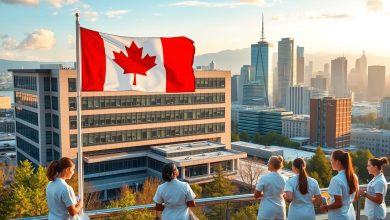Unlocking Success: Top Benefits and Unique Advantages of Visa Sponsorship in the USA
Every year, thousands of skilled professionals seek opportunities to work in the United States.
With over 140,000 employment-based visas available, the process opens doors to diverse industries and career growth.
Sponsorship plays a crucial role in securing legal work authorization. It connects talented individuals with employers who recognize their potential. This partnership often leads to long-term stability and career advancement.
The path doesn’t end with temporary work permits. Many sponsored employees transition to permanent residency, bringing them closer to citizenship. The USCIS oversees this process, ensuring compliance with immigration laws.
Understanding priority dates and visa bulletin updates helps applicants navigate the system efficiently. With the right guidance, the journey becomes smoother and more rewarding.
Introduction to USA Visa Sponsorship
The United States offers a structured immigration system for skilled workers through employment-based programs. Each fiscal year, from October 1 to September 30, approximately 140,000 visas are allocated across five preference categories. These opportunities attract global talent seeking career advancement.
Family inclusion is a key feature. Spouses and children under 21 may accompany primary applicants, fostering stability during relocation. This policy underscores the holistic approach of U.S. immigration policies.
Employment-based visas differ from family preference categories. The former prioritizes skills and employer demand, while the latter focuses on reuniting relatives. Understanding this distinction helps applicants choose the right path.
The visa bulletin system manages demand through priority dates. Applicants monitor these updates to track their place in line. Delays may occur if annual caps are reached.
Basic eligibility requirements apply to all employment categories:
- A valid job offer from a U.S. employer.
- Proof of qualifications (degrees, certifications, or experience).
- Labor certification proving no qualified U.S. workers are available (for some categories).
Navigating this process requires attention to deadlines and documentation. Employers and applicants must collaborate to meet legal standards.
Why Choose USA Visa Sponsorship?
Global professionals gain unmatched career growth through specialized work programs. Over 28.6% of annual allocations prioritize roles requiring advanced degrees or exceptional skills. This system bridges talent with top employers, offering stability and upward mobility.
Access to World-Class Job Opportunities
Fortune 500 companies actively recruit skilled workers for high-demand roles. Industries like tech, finance, and engineering offer salaries 20–40% above global averages. The Department of Labor ensures wage fairness through four tiered levels:
| Industry | Salary Premium | DOL Wage Level |
|---|---|---|
| Technology | 35% | Level 4 |
| Finance | 28% | Level 3 |
| Engineering | 22% | Level 2 |
Pathway to Permanent Residency and Citizenship
Employment-based categories (EB-1 to EB-5) provide clear timelines for green card eligibility. EB-1 applicants often secure permanent status in 1–2 years, while EB-5 investors wait 5–7 years. National Interest Waivers expedite the process for those with exceptional abilities.
Competitive Salaries and Benefits
Sponsored roles include comprehensive packages:
- Health insurance matching U.S. standards
- Retirement plans with employer contributions
- Relocation assistance and visa fee coverage
These advantages solidify long-term career status, making employment-based immigration a strategic choice.
Types of Employment-Based Visa Sponsorship
From Nobel laureates to investors, employment-based categories cater to diverse talents. Each category serves distinct professional backgrounds, ensuring opportunities align with skills and goals. Below is a breakdown of the five preference categories.
Employment First Preference (E1): Priority Workers
The EB-1 category targets individuals with extraordinary abilities, multinational executives, and researchers. Subgroups include:
- Nobel Prize winners or equivalent international awards.
- Executives transferred to U.S. branches.
- Outstanding professors with published work.
No labor certification is needed, speeding up the petition process.
Employment Second Preference (E2): Advanced Degrees and Exceptional Ability
EB-2 suits professionals with advanced degrees or proven exceptional ability. A National Interest Waiver may bypass job offers if the work benefits the U.S. significantly. Success factors include:
- Peer-reviewed publications.
- High salary or industry recognition.
Employment Third Preference (E3): Skilled and Unskilled Workers
EB-3 covers roles requiring at least 2 years of experience or a bachelor’s degree. Labor certification proves no qualified U.S. workers are available. Subcategories include:
| Subcategory | Requirement |
|---|---|
| Skilled Workers | 2+ years’ experience |
| Professionals | Bachelor’s degree |
| Unskilled Workers | Limited to temporary roles |
Employment Fourth Preference (E4): Special Immigrants
EB-4 includes niche groups like Afghan interpreters, religious workers, and retired NATO employees. Each case requires specific documentation.
Employment Fifth Preference (E5): Immigrant Investors
EB-5 applicants invest at least $900,000 in targeted employment areas. Options include:
- Direct Investment: Creating 10+ full-time jobs.
- Regional Centers: Pooled investments in approved projects.
The Step-by-Step Process of USA Visa Sponsorship
Navigating employment-based immigration involves multiple stages, each with specific requirements. From securing labor certification to attending a consular interview, applicants must follow a structured timeline. Delays often occur due to missing documents or policy changes.
Labor Certification and Filing a Petition
The PERM labor certification is the first hurdle. Employers must prove no qualified local candidates are available. This step takes 6–18 months, with audits triggered by:
- Discrepancies in prevailing wage determinations.
- Job requirements deemed overly restrictive.
After approval, employers file Form I-140 to petition for the worker. Common RFE reasons include incomplete experience proofs or mismatched job duties.
National Visa Center (NVC) Processing
Approved petitions move to the NVC, where applicants pay fees ($325–$345 per person). They submit Form DS-260 and a civil documents package, including:
- Passport copies.
- Birth and marriage certificates.
- Police clearance certificates.
Cases remain at the NVC until a consular interview slot opens.
Visa Application and Interview
Embassies schedule interviews after reviewing the visa application. Applicants should prepare for questions like:
- “Describe your job responsibilities.”
- “How does this role align with your qualifications?”
Approvals typically take 1–2 weeks post-interview. Denials may result from incomplete forms or security flags.
Key Requirements for USA Visa Sponsorship
Meeting the criteria for employment-based immigration demands careful preparation from both employers and applicants. Strict guidelines ensure fairness and compliance with labor laws. Understanding these rules helps avoid delays or rejections.
Employer Obligations
Sponsoring companies must prove they’ve made genuine efforts to hire locally first. Key steps include:
- Posting job ads in approved platforms for at least 30 days.
- Documenting recruitment efforts, including interview summaries.
- Paying the prevailing wage based on Department of Labor tiers.
Financial stability is also critical. Sponsors must meet 125% of the federal poverty guidelines when filing the I-864 affidavit.
Applicant Qualifications
Professionals need verified credentials and relevant experience. Common requirements:
- Educational degrees evaluated by accredited agencies.
- Work history matching the job description (minimum 2 years for EB-3).
- Licenses or certifications for regulated fields (e.g., healthcare).
Financial and Documentation Requirements
Both parties must submit authenticated records:
- Tax returns and bank statements for sponsors.
- Police clearance certificates (valid for 6–12 months).
- Medical exams from approved panel physicians.
Missing or expired paperwork is a leading cause of delays. Double-check these before submission.
Understanding the Role of the Department of Labor
The Department of Labor plays a pivotal role in shaping fair employment opportunities. It oversees labor certification to ensure wages and hiring practices protect both workers and employers. Through systems like FLAG, it streamlines PERM applications while maintaining strict standards.
Prevailing wage determinations rely on ONet data, categorizing roles into four tiers. This prevents wage depression by matching salaries to local averages. Employers must adhere to these tiers when filing petitions:
| Wage Level | Experience Required | Example Roles |
|---|---|---|
| Level 1 | Entry-level | Junior Analysts |
| Level 2 | 2–5 years | Software Developers |
| Level 3 | 5+ years | Senior Engineers |
| Level 4 | Specialized | Research Scientists |
Audits are triggered by discrepancies in job postings or wage claims. Employers can defend against audits by:
- Keeping detailed recruitment records.
- Aligning job descriptions with ONet classifications.
- Submitting timely responses to DOL inquiries.
The process extends to EB-3 “other workers,” where the Department of Labor collaborates with State Workforce Agencies. These partnerships help allocate slots for seasonal or temporary roles, balancing labor market needs.
Financial Considerations: Fees and Costs
From filing fees to medical exams, costs add up quickly in the immigration process. Applicants should budget for both mandatory payments and unexpected expenses to avoid delays. Proper planning ensures a smoother journey toward legal work authorization.
Visa Application Fees
The I-140 petition requires a $700 filing fee, while the USCIS immigrant fee is $220. National Visa Center (NVC) processing adds $325–$345 per person. Optional upgrades like premium processing expedite decisions for an additional $2,500.
Medical Examination and Vaccination Costs
Panel physicians conduct medical exams, typically costing $1,000+. Prices vary by country and required vaccinations (e.g., MMR, influenza). Some clinics bundle services, while others charge per test.
Additional Expenses to Anticipate
- Translations: $25–$50 per document for certified translations.
- Notarizations: $5–$15 per signature, often needed for affidavits.
- RFE responses: Legal fees may apply if attorneys handle additional evidence.
Applicants should also factor in travel for interviews or medical appointments. These hidden costs can strain budgets if unplanned.
Family Immigration Through Visa Sponsorship
Bringing family members to a new country involves navigating specific legal protections and requirements. Immediate relatives of approved applicants may qualify for derivative status, but timelines vary by category. IR1/CR1 petitions for spouses typically process faster than F2A applications for minor children.
The Child Status Protection Act (CSPA) prevents age-outs for dependents. If a child turns 21 during processing, their eligibility locks at the petition filing date. This ensures fairness despite bureaucratic delays.
Same-sex spouses receive equal treatment under current policies. Couples must provide marriage certificates and proof of bona fide relationships, like joint financial records.
Medical exams are mandatory for all family members. Panel physicians check vaccination records and screen for communicable diseases. Children under 15 may have simplified requirements.
Sponsors submit separate affidavits of support for each dependent. These documents prove financial capability to avoid public charge concerns. At ports of entry, officers verify paperwork before granting green card status.
Common Challenges and How to Overcome Them
Long wait times and complex eligibility rules create hurdles for many applicants. Some face delays spanning years, while others encounter unexpected denials. Understanding these obstacles helps navigate the system effectively.
Navigating Visa Backlogs
Applicants from high-demand countries like India often wait 3–10 years for EB-2 or EB-3 categories. Cross-chargeability allows using a spouse’s birthplace to bypass queues. Concurrent filing of I-140 and I-485 forms can also save time.
Premium processing speeds up decisions for an extra fee. This option cuts wait times from months to 15 days for eligible petitions. Always check the visa bulletin for priority date updates.
Dealing with Visa Ineligibilities
Section 214(b) refusals occur if applicants fail to prove nonimmigrant intent. To avoid this, provide strong ties to your home country, like property deeds or job contracts. For 221(g) administrative processing, submit requested documents promptly.
Waivers may resolve past misrepresentation cases. Legal counsel can help draft persuasive arguments showing rehabilitation. Medical or criminal ineligibilities often require additional screenings or appeals.
- Documentation: Keep records organized to address RFEs quickly.
- Interview prep: Rehearse answers about job roles and qualifications.
- Appeals: File Form I-290B within 30 days of denial.
Tips for a Successful Visa Application
Proper documentation and interview readiness are critical for successful immigration outcomes. Nearly 30% of refusals stem from incomplete DS-260 forms or mismatched photo specifications. A strategic approach minimizes errors and delays.
Preparing for the Visa Interview
Mock interviews build confidence for consular reviews. Practice answering questions about job roles, qualifications, and intent to return home. Key steps include:
- Reviewing common questions: “Describe your employer’s business model” or “Explain your role’s impact.”
- Organizing paperwork: Keep passports, approval notices, and financial proofs in labeled folders.
- Adhering to photo specs: 2×2 inches, white background, no glasses or headwear.
Avoiding Common Pitfalls
Social media profiles are often reviewed. Delete controversial posts and update privacy settings. Other missteps to avoid:
- Inconsistent financial evidence: Bank statements must match affidavit amounts.
- Missing follow-ups: Respond to RFEs within deadlines—consult an attorney if unsure.
- Overlooking post-interview steps: Track passport return timelines via CEAC.
Post-Visa Approval: What to Expect
After receiving approval, applicants transition to practical steps for relocation and integration. This phase involves navigating entry procedures, securing essential documents, and understanding long-term residency requirements. Preparation ensures a smooth transition to life in a new country.
Entering the United States
Customs and Border Protection (CBP) officers conduct secondary inspections at ports of entry. They verify status by reviewing visa stamps and supporting documents. Global Entry members may expedite this process with pre-screening benefits.
The I-551 stamp serves as temporary proof of permanent residency. It’s valid for one year while awaiting the physical card. Address updates must be reported to USCIS within 10 days of relocation.
Applying for a Social Security Number
A Social Security Number (SSN) is essential for employment, banking, and taxes. Applicants should visit local offices within three weeks of arrival. Required documents include:
- Passport with visa endorsement.
- I-94 arrival record.
- Proof of address (e.g., utility bill or lease agreement).
Adjusting to Permanent Resident Status
Green card production typically takes 3–6 months. During this period, residents must maintain conditional status by avoiding prolonged international travel. Key responsibilities include:
- Filing annual tax returns as U.S. residents.
- Renewing conditional cards (if applicable) 90 days before expiration.
- Updating USCIS after any address changes.
Legal and Financial Responsibilities of Sponsors
The I-864 affidavit binds sponsors to long-term support commitments. This legally enforceable contract requires them to maintain the applicant’s income at 125% of the federal poverty level. Violations can trigger state Medicaid reimbursement claims.
Joint sponsors share liability if the primary fails to meet obligations. Courts may garnish wages or assets to recover public benefits used by the immigrant. Income calculations include tax returns, while assets (e.g., property) must be liquidatable within a year.
The 40-quarter rule terminates financial duties after the immigrant works 10 years (40 quarters) in the U.S. Exceptions apply for military service members, who may pause obligations during active duty.
Contingencies address sponsor death or bankruptcy. Alternate sponsors must file new I-864 forms. Without a replacement, immigrants risk losing status if they rely on means-tested benefits.
Comparing USA Visa Sponsorship with Other Countries
Workers exploring global opportunities often compare immigration policies across leading nations. The united states, Canada, and the UK offer distinct advantages for skilled professionals. This section highlights key differences in processing, costs, and long-term benefits.
Processing times vary significantly. Canada’s Express Entry system averages 6 months, while UK Skilled Worker visas take 3–8 weeks. In contrast, U.S. employment-based categories range from 1–10 years due to annual caps and backlogs.
| Country | Average Processing Time | Base Application Fee |
|---|---|---|
| Canada (Express Entry) | 6 months | $1,365 CAD |
| UK (Skilled Worker) | 3–8 weeks | £625–£1,423 |
| United States (EB-3) | 2–5 years | $700–$2,500 |
Family inclusion policies also differ:
- Canada: Spouses receive open work permits; children access free education.
- UK: Dependents can work but pay healthcare surcharges (£624/year).
- United States: Green cards for immediate family but longer wait times.
Citizenship requirements reveal further contrasts. Canada mandates 3 years of residency, the UK requires 5 years, and the united states enforces a 5-year minimum with stricter physical presence rules.
Job portability favors Canada and the UK. Both allow employer changes without reapplying. The U.S. limits this flexibility—H-1B holders must file new petitions, while green card applicants risk abandoning their process if switching jobs too early.
Resources for Further Assistance
Finding reliable resources can simplify the complex immigration journey. Government agencies and legal experts provide tools to streamline applications and resolve issues efficiently.
The USCIS online portal offers case tracking and form downloads. For visa-specific queries, the Department of State’s Visa Navigator clarifies eligibility and wait times. The American Immigration Lawyers Association (AILA) directory connects applicants with accredited attorney services.
EOIR-accredited representatives assist with appeals or removal proceedings. These professionals are vetted by the Executive Office for Immigration Review. Their guidance is invaluable for navigating court processes.
State Department specialists handle consular-related delays. Applicants can escalate cases through ombudsman offices if standard channels fail. FOIA requests uncover application records, while congressional inquiries expedite stuck petitions.
Always double-check official information before submitting documents. Free clinics and nonprofit organizations also offer workshops to guide applicants through each step.
Conclusion
Navigating employment-based immigration opens doors to global opportunities. With annual quotas and evolving policies, staying informed is key. Professionals can maximize their chances by preparing early and understanding the process.
Emerging trends show faster approvals for high-demand fields like tech and healthcare. A final checklist helps avoid delays:
- Verify all documents before submission.
- Track priority dates regularly.
- Prepare for interviews with role-specific details.
Long-term planning includes exploring permanent residency paths. Many transition to citizenship within 5–7 years. With the right strategy, this journey leads to stability and growth.
For more information explore the official visa website mentioned in this article:
You will be redirected to another website
FAQ
What is employment-based visa sponsorship?
It allows employers to hire foreign workers when qualified local candidates are unavailable. The process involves labor certification and petition filing with U.S. Citizenship and Immigration Services (USCIS).
How long does the process take?
Processing times vary by category. Some cases take months, while others may face backlogs extending several years. Premium processing can expedite certain petitions.
Can family members accompany the primary applicant?
Yes, spouses and unmarried children under 21 may apply for derivative status, allowing them to live, study, or work in the U.S.
What are the employer’s financial responsibilities?
Sponsors must cover filing fees, legal costs, and sometimes relocation expenses. They must also pay the prevailing wage as determined by the Department of Labor.
Is a job offer mandatory for employment-based visas?
Most categories require a valid offer, except for EB-1 (Priority Workers) and EB-2 National Interest Waivers, where applicants can self-petition.
What happens if a visa application is denied?
Applicants receive a reason for denial. Reapplying or appealing may be possible, depending on the grounds for rejection.
Can visa holders apply for permanent residency?
Many employment-based categories lead to a green card. Applicants must meet eligibility criteria and wait for visa availability in their preference category.
Are there annual caps on employment-based visas?
Yes, Congress sets limits per category and country. Some applicants face longer waits due to high demand from certain nations.
What documents are needed for the interview?
Required items include a valid passport, medical exam results, petition approval notice, and proof of qualifications (degrees, certifications, or experience letters).
How can applicants check their case status?
USCIS and the National Visa Center provide online tracking tools using the receipt number from the filed petition.
Published on: 4 de June de 2025








